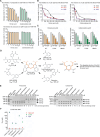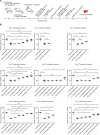Pamoic acid and carbenoxolone specifically inhibit CRISPR/Cas9 in bacteria, mammalian cells, and mice in a DNA topology-specific manner
- PMID: 40156040
- PMCID: PMC11951523
- DOI: 10.1186/s13059-025-03521-w
Pamoic acid and carbenoxolone specifically inhibit CRISPR/Cas9 in bacteria, mammalian cells, and mice in a DNA topology-specific manner
Abstract
Background: Regulation of the target DNA cleavage activity of CRISPR/Cas has naturally evolved in a few bacteria or bacteriophages but is lacking in higher species. Thus, identification of bioactive agents and mechanisms that can suppress the activity of Cas9 is urgently needed to rebalance this new genetic pressure.
Results: Here, we identify four specific inhibitors of Cas9 by screening 4607 compounds that could inhibit the endonuclease activity of Cas9 via three distinct mechanisms: substrate-competitive and protospacer adjacent motif (PAM)-binding site-occupation; substrate-targeting; and sgRNA-targeting mechanisms. These inhibitors inhibit, in a dose-dependent manner, the activity of Streptococcus pyogenes Cas9 (SpyCas9), Staphylococcus aureus Cas9 (SauCas9), and SpyCas9 nickase-based BE4 base editors in in vitro purified enzyme assays, bacteria, mammalian cells, and mice. Importantly, pamoic acid and carbenoxolone show DNA-topology selectivity and preferentially inhibit the cleavage of linear DNA compared with a supercoiled plasmid.
Conclusions: These pharmacologically selective inhibitors and new mechanisms offer new tools for controlling the DNA-topology selective activity of Cas9.
Keywords: Anti-CRISPR; DNA topology; Mice model of hydrodynamic injection; Mode of action; Selective small-molecule inhibitors.
© 2025. The Author(s).
Conflict of interest statement
Declarations. Ethics approval and consent to participate: The animal study was approved by the Institutional Animal Care and Use Committee (IACUC) of Shanghai Jiao Tong University, China. Consent for publication: Not applicable. Competing interests: The authors declare no competing interests.
Figures







References
MeSH terms
Substances
Grants and funding
LinkOut - more resources
Full Text Sources
Miscellaneous

